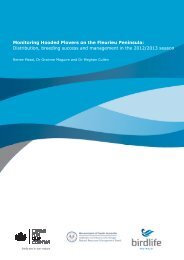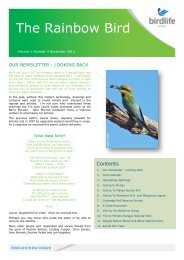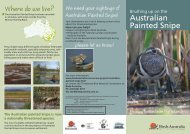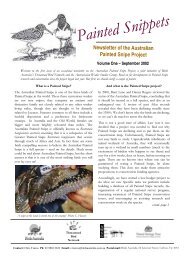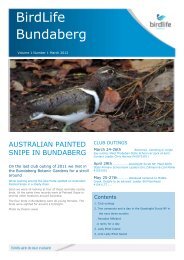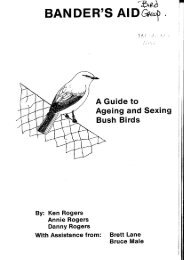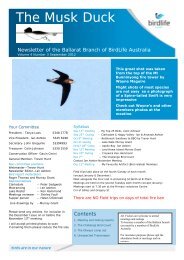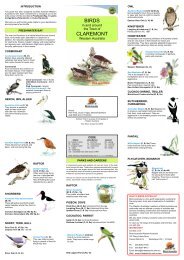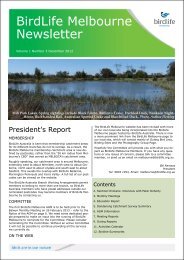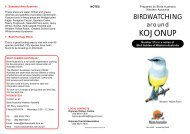Contact Call - Birds Australia
Contact Call - Birds Australia
Contact Call - Birds Australia
Create successful ePaper yourself
Turn your PDF publications into a flip-book with our unique Google optimized e-Paper software.
<strong>Contact</strong> <strong>Call</strong>Apart from size and colouration, which, at best, are afaulty guide in the field, the *Little Yellow Robin isdistinguishable from E. capito and E. leucops by itshabits rather than its habitat. We found it occupyingboth dense scrub and scrub/open forest borders, theborders being the usual haunt of the other twomembers of the genus. However, the Pale-yellowspends much of its time on the ground, and is arelatively quiet feeder, whilst the Little Yellow is almostcontinuously on the move amongst the vine-cladbranches, hunting up insects which it takes on thewing. Its call note uttered with scarcely a break whileit is feeding, is a rather grotesque parody of the pipingof E. australis...."This is a very accurate description of the Yellow-leggedFlycatcher. They go on to say of the Pale-yellow Robin"This species was more common in the Evelyn scrubsthan elsewhere..."Bravery (1970) says "*Little Yellow Flycatcher(Microeca griseoceps) – Rare resident in rainforest andwet sclerophyll, Somewhat like flavisgaster (LemonbelliedFlycatcher) except in feeding habits which arelow in canopy and in outer foliage in wet sclerophyll..."He also records the Pale-yellow Robin as a commonresident in rainforest.An occasional report of the Yellow-legged Flycatchersin the Wet Tropics is still made but all sightingsinvestigated have been Pale-yellow Robins. Confusionoccurs mostly because the Robin has similarly colouredlegs. Hanzab does not give differences betweenYellow-legged Flycatcher and Pale-yellow Robin,concentrating only on those species within theflycatcher's far northern Cape York Peninsula range. Isit worth keeping an eye open for the flycatcher in theWet Tropics in case there is a remnant population stillexisting e.g. on the Atherton Tableland? If so thefollowing may help —The Yellow-legged Flycatcher is largely arboreal,feeding actively in a flycatcher manner, foragingthrough branches and foliage and often takinginsects on the wing. It has grey upperparts,especially on the head; pale-lemon underparts;whitish-grey throat; bright yellow legs; dark greyupper mandible and cream to yellow lowermandible.JOIN US ON FACEBOOKIt is a Yellow-legged Flycatcher IF –1. It spends most of its time high in the rainforestcanopy2. It is continually on the move and usually quitevocal3. It feeds actively on the wing often sallying in shortfluttering flights4. It has a bi-coloured bill5. It has a plain dark-grey face without a spot oneach side of its foreheadIt is a Pale-yellow Robin IF –1. It spends nearly all of its time in the lower layer ofthe rainforest2. It is quiet and unobtrusive, sitting for minutes on aperch or tree trunk (often sideways)3. It often drops to the ground to take prey4. It has an all-black bill5. It has buff lores and spot on each side of itsforeheadNote that both Yellow-legged Flycatcher and PaleyellowRobin have yellow legs. The Lemon-belliedFlycatcher inhabits more open forest and has blacklegs.*The Yellow-legged Flycatcher has had severalcommon names over the years e.g. Little Yellow Robin(Eopsaltria kempi) (1926 RAOU checklist), Little YellowFlycatcher & Yellow-footed Flycatcher (Microecagriseoceps).ReferencesBoles, W.E., 1980 A Notable Record of the YellowleggedFlycatcher <strong>Australia</strong>n <strong>Birds</strong> 15:1:12 1980Bourke. P.A. and Austin, A.F., The Atherton Tablelandand its Avifauna. Emu 47:87–116Bravery, J.A., 1970 The <strong>Birds</strong> of the Atherton ShireEmu 70:49–63Nagle, P., 1987 Yellow-legged Flycatcher Reportedfrom the Atherton Region of North Queensland,Sunbird 17:2–31Noske, R.A. and Sticklin, R. 1979 Nest and Eggs of theYellow-legged Flycatcher Emu 148–49Schodde, R. & Mason, I.J., 1999 The Directory of<strong>Australia</strong>n <strong>Birds</strong> Passerines CSIRO, Collingwood, VicWhite, S.R., 1946 Notes on the Bird Life of <strong>Australia</strong>'sHeaviest Rainfall Region Emu 46:81–122Written by Lloyd NielsenAugust 2013 5



